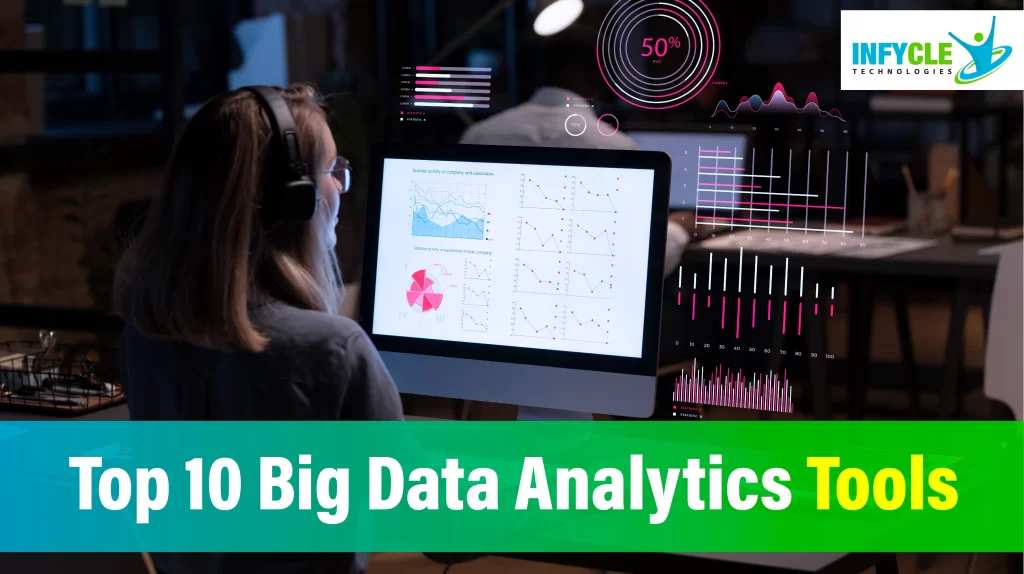Top 10 Big Data Analytics Tools
In today’s IT industry, we understand that data is everything. Moreover, the amount of data is increasing daily at an exponential rate, approaching 2.5 quintillion bytes globally. We used to discuss megabytes and kilobytes in previous years. However, terabytes are the unit of measurement used these days. Explore the top 10 big data analytics tools to effectively manage and analyze this massive data growth.
The importance of data lies in turning it into useful information that can assist management in making smart decisions. Several big data software applications are available on the market to help us with this process. This software facilitates the storing, analysis, reporting, and many other uses of data.
When businesses begin to use big data more effectively, there is an exponential increase in the need for qualified individuals who know how to use these tools. Gaining proficiency with these tools can dramatically improve one’s capacity to obtain useful information, make smart decisions, and maintain a leg up in the competitive market.
Are you an experienced professional looking to add new tools to your toolbox or a beginner excited to dive into the big data world? With these tools, you will be able to meet various requirements and use them in a variety of ways. By joining the best software training institute in Chennai, you will gain a deeper understanding of their characteristics, and strengths, and how they can be used to solve complex data problems.
The top 10 big data analytics tools for 2024 are listed below.
APACHE Hadoop
This open-source platform runs on Java and is used for processing and storing large amounts of data. Because it is based on a cluster system, data may be processed effectively and simultaneously by the system. It is capable of handling both structured and unstructured data from a single server to several machines. Additionally, Hadoop provides its users with multi-platform support. It is now the greatest big data analytics tool, and several tech companies, including Amazon, Microsoft, IBM, and others, use it extensively.
Features:
- It is open to use and provides companies with an effective storage solution.
- It is very easy to use and quite adaptable when working with MySQL and JSON.
- It is extremely scalable since it can split up big data into smaller portions.
- It operates on several discs or small, common hardware like JBOD.
Cassandra
One of the best distributed databases without a SQL engine is Cassandra, which is very good at fetching large volumes of data. Many tech companies have spoken highly of it for its reliability and capacity for growth without sacrificing speed or performance.
Cassandra can process petabytes of data with very little downtime and perform countless operations per second. This amazing big data tool was first developed by Facebook in 2008, and it never fails to amaze with its potent powers and performance-driven methodology.
Features:
- Cassandra facilitates fast data archiving and effective data processing on commodity hardware.
- Depending on user needs, data can be structured, semi-structured, or unstructured.
- With replication, sharing data throughout several data centres is simple.
- When a node malfunctions, it is replaced promptly.
Apache Spark
Spark is an open-source platform for organizing, processing, and analyzing big data. This was initially developed at UC Berkeley’s AMPLab in 2009 and later made available as an Apache project in 2010.
In Spark, data parallelism and fault tolerance are implicitly supported across entire clusters. It is well-known for its quickness, user-friendliness, and ability to handle a variety of workloads, such as network processing, artificial intelligence, and batch computation.
Features:
- Users can operate in the language of choice. (PHP, Java, and so forth)
- By using Spark Streaming, Spark can manage live streaming.
- It can operate on the cloud, Kubernetes, or Mesos.
Tableau
Tableau, which is well-known for having a large number of interactive visualizations for data analytics, has an easy-to-use drag-and-drop interface. Several formatting tools are available on this platform to assist in customizing visualizations. Tableau users may easily connect to a variety of data sources, which makes statistical analysis and the development of predictive algorithms easier. A data analyst or developer usually uses Tableau to create accurate visual representations of data. Tableau’s setup might be difficult for business users because of the necessary process of learning to acquire the fundamental skills.
Features:
- With Tableau Prep, you can clean, transform, and reshape data using a visual and user-friendly interface.
- With its built-in features, Tableau may be used for complex analytics such as predictive modelling, forecasting, and trend evaluation.
- Using Tableau Server and Tableau Online, you can share insights with others by publishing dashboards.
- Tableau facilitates real-time data analysis, mobile device accessibility to visualizations, and connections to several data sources.
Data Pine
Datapine, an operational intelligence analysis company, founded in 2012, has its headquarters located in Berlin, Germany. Since its launch, it has become incredibly popular across several countries, particularly among small and medium-size enterprises that require data extraction for monitoring. Because of the improved user interface, anyone may access the data based on their needs and choose from four price ranges, beginning at $249 per month. Dashboards are accessible based on functions, industry, and platforms.
Features:
- Datapine offers predictions and statistical analysis using both historical and current data.
Artificial intelligence (AI) assistants and BI tools were created to reduce manual labour.Datapine offers predictions and statistical analysis using both historical and current data. - Artificial intelligence (AI) assistants and BI tools were created to reduce manual labour.
SAS (Statistical Analytical System)
It is one of the greatest tools available today for data analysts to build statistical frameworks, and data scientists can employ it to mine, gather, and update data from multiple sources. You can view data through SAS (Statistical Analytical System) tables and Excel worksheets. Furthermore, SAS recently released new big data tools and products to further reinforce its hold on machine learning and artificial intelligence.
Features:
- Non-programmers will find it appealing due to its straightforward syntax and extensive resources.
- Data can be processed in any form and is accessible with a variety of computer languages, such as SQL.
RapidMiner
When separating data is necessary, RapidMiner is a platform that uses easy-to-use visual tools to streamline data analytical activities, saving code. RapidMiner makes big data analytics easier and faster, widely used in various industries such as research, development, and education technology.
When you set up the user interface for collecting data in real time, customers can utilize RapidMiner to deploy machine learning algorithms to mobile or online platforms. This adaptable and user-friendly technology simplifies data analytics chores, which makes it a top option for companies looking to extract valuable insights from their data.
Features:
- You can access other file types (such SAS and ARFF) through URLs.
- Rapid Miner enables the history of many results to be highlighted for improved evaluation.
Cloudera
A software platform called Cloudera enables businesses to set up, maintain, and safeguard their big data programs within the company, cloud-based, or hybrid settings. Although it is based on Apache Hadoop, it can handle and analyse large amounts of data more effectively by including technologies like Apache Spark, Apache Hive, and Impala.
Features
- Provides an extensive range of tools for data processing, statistical analysis, and machine learning.
- Offers strong security features like as auditing, authorization, and verification.
- Allows for both on-premises installs and deployment across several cloud platforms.
Qubole
Qubole is the most advanced big data analytics platform that uses open-source technologies to gather information from several sources along its value chains. Ad hoc analysis and machine learning efficiently retrieve and process data.
Qubole reduces time and effort by providing end-to-end services for smooth data pipeline flow. It optimises up to 50% of cloud computing expenses and allows you to set up Amazon Web Services (AWS), Azure, and Google Cloud services simultaneously. This makes Qubole an attractive and affordable option for companies interested in simplifying their big data analytics procedures and cloud-based services.
Features:
- Qubole provides predictive analysis to focus on more acquisitions.
- With this technology, data from multiple sources can be conveniently moved to a single location.
- In addition to monitoring their systems, users can see real-time data in them.
Apache Storm
Apache Storm is one of the most popular big data analytics tools among small companies with limited resources because it is robust and user-friendly. Because of its language-neutral design, it is very user-friendly and compatible with a wide range of programming languages.
Storm has the ability to tolerate errors and the horizontal scalability to handle large data sets efficiently. It is a great option for real-time data processing because of its integrated big data processing technology. Many leading companies in the tech sector, such as Zendesk, Twitter, and NaviSite, widely use and consider APACHE Storm reliable.
Features:
- One node may handle up to one million data per second using APACHE Storm.
- Storm analyzes data continuously even when a node is disconnected.
Conclusion
Now that you know what big data predictive analytics tools are available, you should have a clear perspective on their features. These tools can help a person or organisation become more proficient at making business-related decisions. If you are interested in learning more about big data analytics tools and how to use them, you can take a Big Data Hadoop Training In Chennai. Take this course to develop powerful skills in the field of big data while working with the top tools and technologies available.





